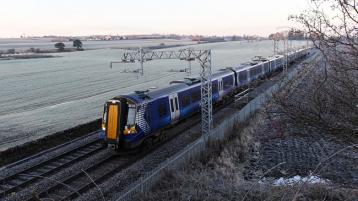ScotRail has confirmed 150 more services will be added to their timetable as they start to re-build Scotland’s Railway following the COVID pandemic and ensure it is fit for the future.
The announcement forms part of the response to a recent public consultation into our proposed new timetable.
From May 2022, ScotRail will operate around 2,150 daily services providing more than 590,000 seats. That is an increase of nearly 150 services each day compared to when the consultation began last year and more daily seats than was provided in 2018 when 97 million passengers used our services.
With the temporary timetable still in operation, the additional 150 services being added in May is based on the December 2021 timetable. That timetable will be reintroduced later this month.
Customers will benefit from a more reliable service than was operating before the pandemic because of lessons learned during the pandemic which have improved train punctuality and reliability.
Based on the consultation feedback, we are making some alterations to our initial proposals in different parts of the country where it has been supported by the available data:
- A direct service will operate all day between Perth and Kirkcaldy rather than via Dunfermline as was proposed. More services will also operate during the evenings in Fife.
- An additional early morning service will operate from New Cumnock to Glasgow and evening peak and late evening services from Glasgow to Dumfries.
- The interval between services at the stations between Perth and Inverness is better spaced with more trains stopping at some stations.
- A half-hourly service will operate during the day on the Borders railway on a trial basis to test how quickly off-peak demand recovers and grows beyond pre-pandemic levels, compared to the original proposal of an hourly off-peak service.
- More services will be added to the Edinburgh Waverley – Glasgow Central via Carstairs and via Shotts routes in December 2022 and May 2023 due to a delay in driver training caused by the pandemic.
We received 3,450 responses, which is more than for any other consultation in ScotRail’s history, and the consultation website was viewed more than 25,000 times.
The consultation was launched in August 2021 after the impact of coronavirus transformed travel patterns and accelerated pre-pandemic trends:
- Almost half of those who responded to the consultation said they previously took the train to work every day but will work from home some of the week for the foreseeable future.
- At the height of the pandemic, passenger numbers dropped by 95 per cent.
- ScotRail made twelve timetable changes during a period when normally there would only be three, giving us concrete evidence upon which to base our future timetables.
- The morning and evening rush hour have changed, with more journeys spread throughout the day and a greater focus on travelling for leisure rather than for work – the busiest days of the week are now Fridays and Saturdays.
- While off-peak travel recovered to 82 per cent of 2019 levels towards the end of 2021, peak and commuting travel only recovered to 47 per cent. We forecast that the new timetable will help off-peak travel fully recover to 2019 levels by the end of 2022. It isn’t yet clear if peak and commuting journeys will ever return to 2019 levels. The timetable has enough capacity to accommodate the numbers of commuters who travelled in 2018.
- Even before the pandemic, on average, each seat was empty for 77 per cent of its journey. The new timetable has plenty of seats for those forecast to travel and we will add more if actual passenger numbers exceed our forecasts.
We have been able to continue to operate services during the pandemic due to emergency taxpayer support from the Scottish Government – through the Emergency Measures Agreements (EMA) – of more than £500million. This has protected ScotRail jobs without using furlough, cutting wages, or reducing staff benefits. Around 60 per cent of pre-pandemic passengers have returned to using the railway.
David Simpson, ScotRail Operations Director, said:
“We know our customers want more trains, so we are pleased to be able to add 150 more services to the timetable from May 2022, delivering a service that is safe, reliable, green, clean, and fit for the future.
“This timetable is the start of the process of recovering from the pandemic and as passenger numbers increase, we will keep the number of services under regular review.
“What is clear from the evidence we’ve made publicly available is that providing a good rail service does not on its own attract significant numbers to public transport. Train operators, government, and trade unions need to work together to encourage other policy levers to be used.
“We are grateful to everyone who took part in the consultation and shared their views. We welcome all feedback and where passenger demand justifies more trains, we’ll do our best to deliver.”
Jenny Gilruth MSP, Minister for Transport, said:
“I’d like to thank everyone who took the time to give their views and experiences in this consultation. It’s important that people have their say when changes to the timing and frequency of rail services are proposed and I’m pleased that ScotRail listened and responded by revising the proposals to ensure that post-pandemic, more people will have more opportunities to travel in Scotland by train.
“From May, there will be 150 more services operating than in December 2021. This new timetable will help us all recover from the impacts of the pandemic and provides us with a solid starting point to offer rail passengers a more reliable service which is fit for the future.”
You can read the detailed response to the timetable consultation here – https://www.scotrail.co.uk/about-scotrail/fit-future





